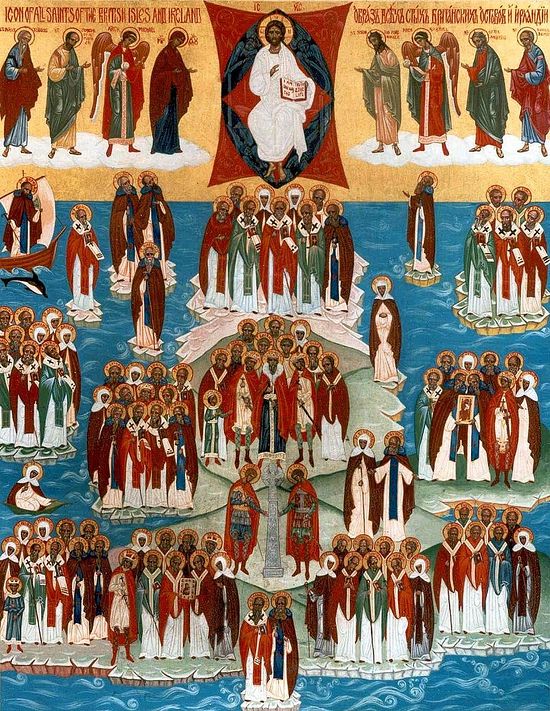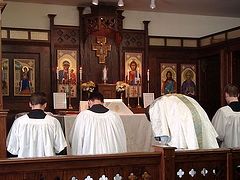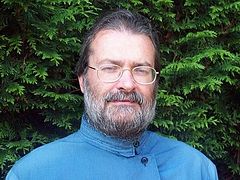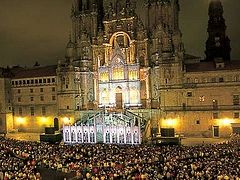Answers to Questions in Recent Correspondence
Q: Fr Andrew, when did you become interested in the Local Saints?
A: Almost exactly fifty years ago when I was nine years old, at school I read about the saintly Alfred the Great and did a child’s project on him. From here I began enquiring about nearby places that commemorated such saints. Near where I lived there was a little place named after St Albright (Ethelbert + 794) and the town of St Osyth (+ c.700), the town of Bury St Edmunds (St Edmund + 869), the town of Ely (St Audrey + 679) and Felixstowe (St Felix + 647) and a railway station named after St Botolph (+ 680). However, as a child, all I could do was ask questions of adults and wonder who these men and women had been and why they were called saints, who must have been great because 1300 years later people still remembered them in place names.
The year after that, when I was ten years old, there was the 900th anniversary of the so-called Battle of Hastings. I understood that something catastrophic had happened then, which had destroyed and buried a whole, mysterious English Christian Civilization together with all these saints and holiness. And that was kept secret.
It was only in my teens that I began reading and wondering why exactly these saints had been forgotten and hidden and how a whole new layer of unsaintliness and even anti-saintliness had covered them over, obscuring them. The other question that I asked myself was why there were no longer any saints, no new saints, only these ancient ones. The source of holiness had clearly dried up. No-one was interested in holiness any more. We now lived in a different Civilization, with different values, alien to me. Why? That was a question that no-one around me could answer, so I read and understood that it was because the Church, the source of all holiness, had been lost. Without the Church there is no holiness, no saints, because only the Church is Holy.
Q: How did the Church lose the memory of these saints?
A: The memory of major or international Orthodox Saints of the West has never been lost by the Church: for example, many of the Roman martyrs like St Tatiana or St Anastasia and others like St Alexis, St Justin Martyr, St Irinaeus of Lyon, St Hilary of Poitiers, St Ambrose of Milan, St John Cassian, St Martin of Tours, St Leo the Great, St Gregory the Dialogist and St Martin of Rome have always been well-known and always been in the Church calendar. But the local Western saints, commemorated only in certain limited regions or even individual villages in Western Europe, were lost, quite simply for geographical reasons. When Orthodox no longer lived locally, then there was simply no-one left to venerate them and their memory was increasingly lost.
Q: Did Catholics not venerate them then?
A: Only to a very small extent; they had largely replaced the saints with new individuals, philosophers and the spiritually deluded, Anselms, Bernards, Dominics, Teresas and what have you. In other words, they replaced the first millennium with the second, that is, they replaced Orthodoxy with Catholicism. For Orthodox these new figures are not saints, since they have a quite alien mentality to that of the Church. Here is the reason why today we know so little about most of the saints – they were forgotten or their real Lives were replaced by false lives, legends and folklore. Even today you can go to Irish villages and instead of the local sixth-century Irish hermit being commemorated, you will find that the local church is dedicated to Bernadette and has a grotto with a statue. A completely alien mentality.
As for the Protestants, they of course completely denied the saints in their general rejection of even the concept of holiness and ascetic life. Nowadays, the ever more protestantized Catholics have stopped venerating the relics of the saints; for instance, in Bari in Italy, it is only Russian Orthodox who venerate St Nicholas, the Catholics have forgotten him. Relics in Catholic churches are kept tucked away in glass boxes in accessible places. And if you go to the Vatican and ask to venerate the relics of St Peter, they will tell you that you have to send a letter asking for permission three weeks in advance! They have lost it.
Q: How did the revival of veneration of these local saints begin among Orthodox?
A: Without doubt this was due to St John of Shanghai, when he became Archbishop of Western Europe in the 1950s. He loved the saints and was no narrow nationalist.
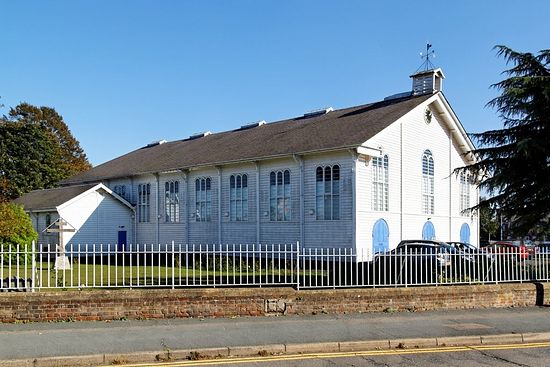 Church of St. John of Shanghai, Colchester.
Church of St. John of Shanghai, Colchester. Q: Was it he who influenced you?
A: No, not at all. I had never heard of him then. I came to venerate these saints quite independently, in childhood, as I described. In any case, I only discovered St John in 1978, long after I had done a great deal of research and reading on these saints in Oxford, made pilgrimages to many sites and compiled a calendar in 1975. In Oxford St John had been kept a secret from me. However, the discovery of St John was reassuring because it confirmed my inmost intuitions and he was in fact the only one who spiritually, if invisibly, supported me. Obviously, I don’t compare myself to him, but there were and are parallel paths in the lives of many people who have come to venerate the local Western saints.
Q: So no-one else you knew was interested at that time?
A: One person who had an academic interest was the then Fr Kallistos, who, as he told me in 1976, liked St Cuthbert and St Bede the Venerable, though he never expressed this publicly and there were no icons of local saints in the Oxford parish at that time. Indeed, many parishioners there were very hostile, dismissing these saints as some personal fantasy of my own and as ‘not Orthodox’. My heart had told me differently and I felt sorry for their ignorance and narrow ethnic and political views. However, also in 1976 Fr Benedict Ramsden showed me the draft Canon to the Saints of the Isles that he had written. That was inspiring.
Q: What was the attitude of Metr Antony (Bloom)?
A: I spoke to him about the subject in 1977 and he clearly had no interest in these saints at all at that time, but I think he changed in about 1990, because he realized that he was losing people to the Church Outside Russia (ROCOR), which was interested. So it was a question of keeping up with the competition.
Q: And the attitude of Fr Sophrony (Sakharov)?
A: He had no interest either, nor did any of his monks. Abbot Kyrill told me in 1977 that since the Cypriots did not venerate the local Western saints, Tolleshunt Knights would not promote them. Of course, such an attitude drove those who did venerate the saints away to jurisdictions that were interested.
Q: Why do you think that Fr Sophrony was not interested?
A: Fr Sophrony, as you know, was a philosopher and an artist and was fascinated by expressing philosophically his experience of meeting a peasant saint, St Silouan. His great interest was in the saint’s words, ‘Keep your mind in hell and do not despair’, even though these are essentially not new words, being the words of the Holy Scriptures, Matt 16, 18 and 2 Cor 4, 8. St Silouan’s revelation was the same as that of all the saints throughout the ages, but Fr Sophrony spent his whole life working on the philosophical implications of those words. Remember he had been the librarian at St Panteleimon’s, where he had met Fr Silouan – he was very erudite. Tolleshunt Knights probably has the best Patristic library in this country, where Orthodoxy ascetics can be studied.
Q: When did you begin writing about the saints?
A: In 1974. In 1977 for the first time I hesitantly showed someone, one of the nuns at Tolleshunt Knights, one of my articles, but she was not interested and simply said that the article was ‘poetic’. She later left the convent there and went back to being Anglican. Publication of my writings did not follow until the very late 1980s and early 90s.
Q: But surely, there were other individuals who were interested in these saints?
A: Yes, some individuals. In parallel to me, though I did not know it at the time, in the early 70s Fr Mark (Meyrick – Fr David when he became a monk) of the ROCOR chapel in Walsingham began including saints’ names in his St Seraphim’s calendar, but he seemed to have a view that only Celtic saints, however obscure, should be included. I first met him in 1976, but I could not understand a certain hostility to the English and other Western saints, especially when he lived in England and he was so English. It was very insular.
Two of his Anglican converts compiled a small book about these Celtic saints, some of them very obscure, but they mainly copied from the 19th century Anglican writer Baring-Gould, though they added troparia that they had written. They seemed to think that only Celts or those who had lived before the seventh century could be saints. But I was still encouraged by this, since I had had no support at all until then and was quite isolated. Moreover, very importantly, Fr Mark was the first to begin painting icons of these saints, notably St Alban (+ c. 304) and St Columba (+ 597), though not St Augustine (+ 604).
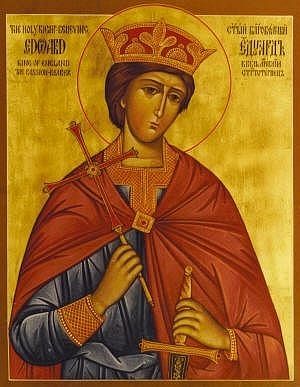 St Edward the Martyr
St Edward the Martyr Then there was a Greek bishop in London, the late Bp Christopher of Telmissos, who in 1985 wrote a booklet about these saints in Greek. In 1989 I discovered that Fr Peter (Cantacuzene – later Bp Ambrose of Vevey) of ROCOR had composed a service to All the Saints of Switzerland. In 1992 I discovered the veneration for the Portuguese and Spanish saints in Portugal and I learned that similar processes were going on in Sweden and Germany. But all these movements were linked with ROCOR.
Q: Why was it that ROCOR began everything in this field and no other jurisdictions showed any interest at all until later?
A: Simply because the other jurisdictions were inward-looking, either engrossed in their home-countries’ politics and identities or else local personality cults. ROCOR had lost its home-country and could not return to it. As a result, some simply lived in the past, in a cultural nostalgia, a kind of Russian Edwardianism. But others realized that the future was in incarnating ourselves as Orthodox without compromise in our countries of adoption. We were precisely the Church Outside, not inside, Russia. That is why in ROCOR we have had had magazines like Orthodox America, Orthodox Australia and Orthodox England. It is the principle of the Incarnation. Other jurisdictions were either interested only in nationalist politics, Greek, Soviet or Balkan, or else some vague, academic, woolly, disincarnate, philosophical, Oxbridge ‘spirituality’, which feeds only the brain, never the heart. That is self-satisfying consolation for intellectuals only. This is part of modernism.
Q: So when did people outside ROCOR start becoming interested?
A: First of all, in the 1990s, if not earlier, there was the calendar of the Greek Orthodox Fellowship of St John the Baptist, edited by the then Bp Kallistos and other ex-Anglicans, which began including some of these saints, as Fr Mark of ROCOR had been doing for some 20 years already. Then in 1996 a group of 300 Anglicans joined the Patriarchate of Antioch and they started venerating these saints and dedicating their churches to them. That was very refreshing. After this the veneration of Local Saints and pilgrimages to them became fashionable, quite incredibly.
A great step forward was the appointment of the then Bishop Elisei as head of the Sourozh Diocese in 2006. People who had scorned me in the 70s and 80s suddenly became interested! If only Bishop Elisei had been there in the 1970s! What I had written in the 70s and 80s was published and even translated into Russian and parts into other languages. After about 2000 people like Misha Sarni of Sourozh and also the excellent Dmitry Lapa in Moscow became very interested.
Q: When did you compose the first services to the local saints and which ones have you done?
A: I began in 1998 or 1999 with services to St Edmund, St Felix and St Audrey, then to All the Saints of the Isles and later, in 2014, to All the Saints of the Lands of Europe. These efforts are of course dwarfed by the work of Isaac Lambertson, who has composed services to dozens of saints of the Western Lands, all the main saints. Our debt to him is huge for this and for his translations.
Q: What for you was the highlight?
 Inside the chapel dedicated to all the Saints of Britain and Ireland.
Inside the chapel dedicated to all the Saints of Britain and Ireland. A: I think in 2008 when we opened the first ever chapel to All the Saints of the Isles, in my native town of Colchester. An ambition forty years old had been realized! Then in 2012 we at last had a new icon of All the Saints of the Isles painted for the iconostasis, which corrected the pioneering work of dear Fr Mark.
Q: What of the future?
A: In Moscow they are still thinking of incorporating some of these saints, who were already venerated in the first millennium in the West, into the Russian Church calendar, at least St Alban. They have been considering this for at least eight years. But this would merely mean catching up with the last 60 years of developments here. Sometimes someone starts something in the provinces and only later do others in the Centre catch up. One of the problems for them is the pronunciation of unfamiliar names like Alfred and Ethelbert and the fact that they are Catholic-sounding, though if you translate them into Russian, they come out more or less as Miroslav and Svetoslav.
Q: What advice would you give to those who want to venerate these saints? Do we accept everyone up until 1054?
A: The Schism was not an event, but a process. It is still going on, the process of substituting human sin for Divine revelation, man-worship for the worship of the God-man, the essence of the Schism, continues to this day. But the question for us is when exactly did people begin falling away from the Church?
As we can see from the Greek Archbishop of Canterbury, St Theodore (+ 690) or the Greek Pope of Rome, St Zacharias (+ 752), the process of Schism clearly did not start until the mid-eighth century. However, there was a bad period with the heretical and genocidal King of the Franks, Charlemagne (Blessed Charlemagne for the papists), and his Council of Frankfurt in 794. But Charlemagne died in 814 and his heresies and so-called ‘empire’ collapsed and Orthodoxy revived. In Rome they did not accept his heresy and dismissed him as an ignorant, power-grabbing barbarian.
There was another bad period in the late ninth century, corrected by the anti-filioque Council of Constantinople in 879-80 and Pope John VIII, assassinated for his Orthodoxy and anti-filioquism in 882, but it left the memory of the heretical Pope Nicholas of Rome (St Nicholas for the papists). This occasioned the work of St Photius against the filioque heresy. Then there was a revival of Orthodoxy in Germany with the Greek Empress of the West, Theophano (+ 991). However, we can also see the spiritual decline of the West from the end of the tenth century, when the first signs of feudalism – thoroughly alien to Christianity – appeared. Probably in 1014 the filioque was sung at Rome for the first time. At the same time there were ever fewer pilgrims from the West going to Jerusalem and Constantinople and ever fewer Greek monks and clergy visiting the West. This was symptomatic of a spiritual change, a decline.
In other words, we have to look very carefully at the lives of anyone in the West, especially in what is now Germany and northern France, after the mid-eighth century until the mid-eleventh century, the symbolic date of 1054. However, we also have to look carefully after this in certain regions, because there were Orthodox saints on Western territory even after 1054, probably in England until at least 1066 (though not the half-Norman traitor Edward), perhaps in Celtic areas and Scandinavia even after this, and certainly in Greek Sicily and Calabria, where Orthodoxy survived intact until at least into the twelfth century.
Q: What is the importance of the venation of these saints?
A: The veneration of these saints means the reintegration and reincorporation of Western people into the holiness of the Church. That is spiritually significant, not only personally, but nationally. There can be no salvation for the separated Western world until this happens. Eschatologically, it is part of the gathering in of the Church before the end, the coming together of the Church in heaven, the saints, and the Church on earth, us.

